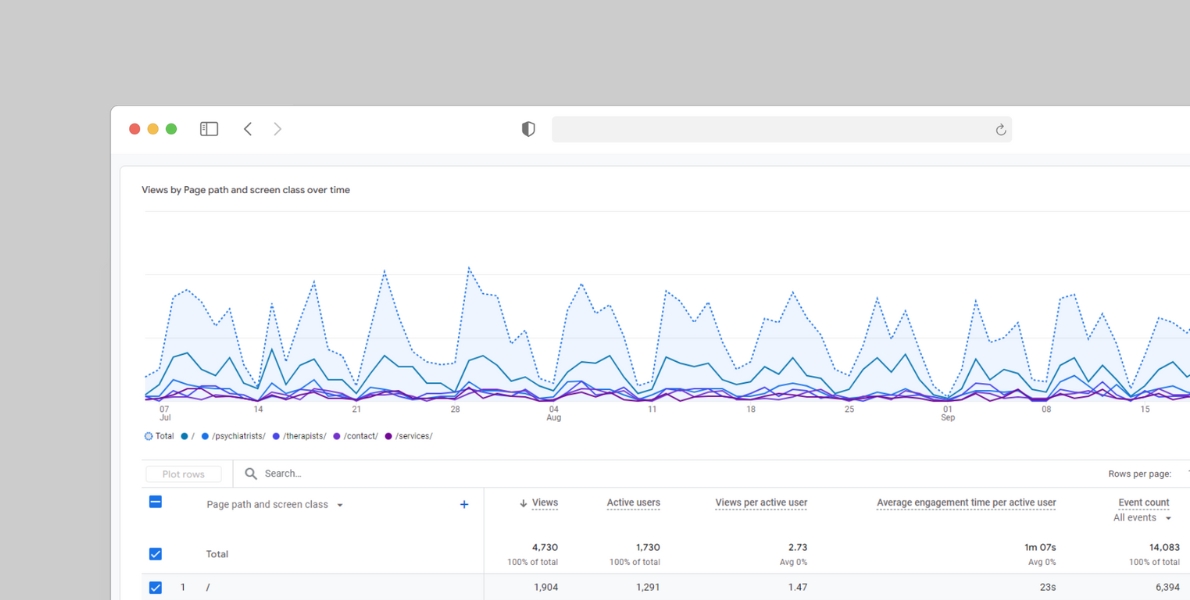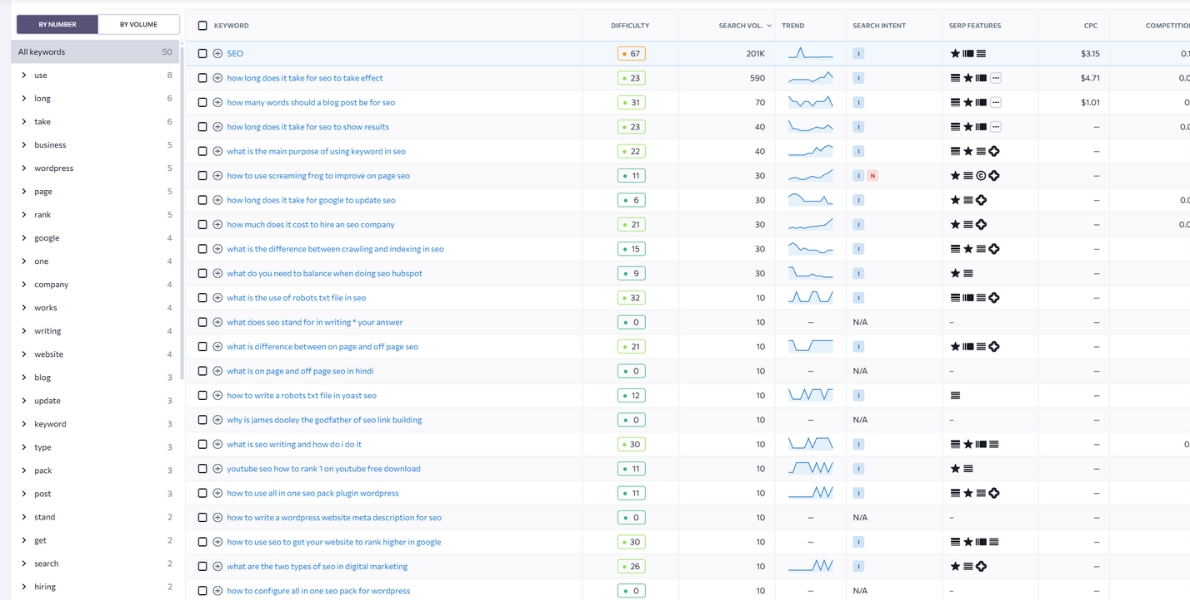Did you know that 68% of online experiences start with a search engine? This shows how crucial it is to know what people are searching for. Good keyword research is key to any online success. In this guide, we’ll teach you how to select SEO keywords worth actual value.
By finding the right keywords, you match your content with what users want. This makes your site more likely to show up in search results. Google Keyword Planner is a great tool for finding trending searches.
At DiviCode, we’re all about web design and SEO. We focus on keyword research to make your content hit the mark. This strategy brings in more visitors and makes your site more visible.
Key Takeaways
- Keyword research is essential for understanding audience needs.
- Aligning content with search intent improves rankings.
- Tools like Google Keyword Planner offer valuable insights.
- DiviCode provides expert web design and SEO services.
- Effective research drives traffic and enhances visibility.
Understanding the Fundamentals of Keyword Research

Keyword research is vital for any online success. It reveals the terms people use to find solutions. By focusing on these terms, you can create content that meets their needs and boosts your visibility.
What Keyword Research Entails
This process involves finding the words and phrases people search for. Tools like Google Keyword Planner give insights into search volume and competition. By analyzing these, you can pick terms that attract more visitors.
Good research also considers what users want. Are they searching for information, products, or services? Knowing this helps your strategy meet its goals.
Key Benefits and Trends
Keyword research has many benefits. It helps you create relevant content, improve rankings, and increase organic traffic. Keeping up with trends keeps your strategy effective.
- It uncovers high-performing terms for your niche.
- Trends like voice search and long-tail keywords shape modern research.
- A well-researched post can significantly boost engagement.
At DiviCode, we offer comprehensive SEO services. Our approach uses the latest trends for maximum impact.
Defining Your SEO Goals and User Intent

Understanding search intent is key to creating effective content. It makes sure your content meets what your audience is looking for. By setting clear goals, you can create strategies that engage and convert users.
Recognizing Different Search Intent Types
Search intent has four main types:
- Informational
- Navigational
- Commercial
- Transactional
Informational queries seek answers or knowledge. Navigational searches aim to find a specific website or page.
Commercial intent involves comparing products or services while transactional searches indicate a readiness to purchase. Knowing these types helps tailor your content to meet user needs effectively.
Aligning Content with User Needs
To align your content with user intent, start by analyzing search data. Tools like Google Keyword Planner and SEMrush provide insights into trending queries. These platforms help you identify long-tail terms that match specific intent types.
For example, targeting long-tail phrases like “best budget laptops for students” caters to commercial intent. This approach boosts relevance and click-through rates. At DiviCode, we specialize in crafting strategies that align your content with user needs.
Here’s how you can optimize your approach:
- Analyze your current content to identify gaps in meeting user intent.
- Use tools to uncover high-performing long-tail keywords.
- Adjust your content to address specific intent types, such as informational or transactional.
By focusing on user intent, you create content that resonates and drives results. DiviCode’s expertise ensures your strategy is both effective and aligned with your goals.
Effective Strategies on how to select SEO keywords

Building a strong online presence starts with a well-crafted keyword list. This list is the backbone of your content strategy. It helps you target the right terms to attract your audience.
A thoughtful approach helps you uncover valuable ideas that align with your business goals.
Establishing a Keyword List
Start by brainstorming terms related to your niche. Think about the words your audience might use to find your products or services. Tools like Google Keyword Planner can help expand your list by suggesting related terms and phrases.
Consider both short-tail and long-tail keywords. Short-tail terms are broad and competitive, while long-tail phrases are more specific and often easier to rank for. Including a mix of both ensures you capture a wider range of search queries.
Determining Relevance and Volume
Once you have a list, evaluate each term’s relevance to your business. Ask yourself if the word aligns with your offerings and audience needs. Next, analyze search volume to gauge potential traffic.
High-volume terms can drive significant visitors, but they often come with higher competition. For example, a term like “affordable laptops” might have a high search volume, but “best budget laptops for students” could be more relevant and easier to rank for.
Here are some actionable tips to refine your keyword list:
- Use analytics tools to identify high-performing ideas in your niche.
- Prioritize terms that align with your business goals and audience intent.
- Regularly update your list to reflect changing trends and search behaviors.
An optimized keyword list not only improves your content strategy but also drives targeted traffic to your site. By focusing on relevance and volume, you ensure your efforts yield measurable results.
Utilizing Keyword Research Tools and Techniques

Mastering keyword research requires the right tools and techniques. These resources simplify the process of finding high-potential terms that align with your audience’s needs. Whether you’re a beginner or an expert, leveraging the right tools ensures your efforts are precise and effective.
Exploring Free and Paid Keyword Tools
Several tools are available to streamline your research. Free options like Google Keyword Planner and Ubersuggest provide valuable insights into search volume and competition. Paid tools like Ahrefs, Semrush, and SE Ranking offer advanced features, including competitor analysis and trend tracking.
Free tools are ideal for beginners or those with limited budgets. Paid options, on the other hand, are better suited for in-depth analysis and scaling your strategy. Choosing the right tool depends on your goals and resources.
Interpreting Data from Google Trends and Keyword Planners
Google Trends helps you identify trending topics and seasonal patterns. This data ensures your content remains relevant and timely. Keyword Planner, on the other hand, provides detailed metrics like search volume and competition levels.
For example, analyzing trends for “long long-tail keyword” can reveal rising interest in specific phrases. Combining this data with Keyword Planner insights helps you prioritize terms with high potential.
Leveraging Seed Keywords
Seed keywords are the starting point for your research. They spark ideas and help find related phrases. Tools like Semrush and Ubersuggest suggest more ideas and long-tail options.
For example, starting with “page optimization” can lead to “best practices for page speed” or “page SEO tips.” This makes your list complete and focused on what users want.
| Tool | Features | Best For |
|---|---|---|
| Google Keyword Planner | Search volume, competition | Beginners, budget-friendly |
| Semrush | Competitor analysis, trend tracking | Advanced users, scaling strategies |
| Ubersuggest | Keyword suggestions, content ideas | Mid-level users, content planning |
Using these tools and methods, you can improve your keyword list. DiviCode uses these resources to create effective solutions.
Analyzing Competitor SEO Strategies

Looking at what competitors do can show you new chances in your field. You can learn from their strengths and weaknesses. This helps you improve your own strategy and stand out.
Conducting Competitor Analysis
First, find your main competitors. They are businesses or websites that do well for terms related to your product or service. Use tools like Semrush or Ahrefs to check their performance. Look at their top pages, backlinks, and keywords.
Notice their content and how users interact with it. Do they use videos, blogs, or infographics? Knowing their methods helps you make a better list for your site. DiviCode’s analysis services make this easier, giving you insights tailored to your needs.
Identifying Keyword Gaps in the Market
Keyword gaps are terms your competitors rank for but you don’t. These are chances to get more organic traffic. Use tools like Google Keyword Planner or Ubersuggest to find these gaps. Look for phrases with lots of searches but not much competition.
For instance, if competitors target “affordable laptops” but miss “best budget laptops for students,” you can use this gap. Update your content to include these terms, making your list complete and competitive.
Here are some steps to improve your strategy:
- Analyze competitor rankings to find top product-related terms.
- Use research tools to find keyword gaps and trending phrases.
- Update your content to cover these gaps, making it match what users want.
By focusing on competitor analysis and keyword gaps, you can boost your strategy. DiviCode’s expertise helps make your efforts effective and goal-oriented.
Incorporating Technical SEO and Detailed SEO Reports

Technical SEO is key to making your website search engine-friendly. It focuses on the backend elements that affect your site’s visibility and user experience. By improving these areas, you can rank better and attract more visitors.
Understanding Technical SEO Factors
Several technical aspects impact your website’s performance. Site speed, mobile-friendliness, and structured data are crucial for a good user experience. A fast site keeps visitors interested, and mobile optimization makes your site accessible everywhere.
Structured data helps search engines understand your content better, increasing your chances of showing up in rich results. Regular audits of these factors keep your site optimized for both users and search engines.
Utilizing SEO Reporting for Ongoing Improvements
SEO reporting is key to tracking your progress and finding areas to improve. Detailed reports give insights into your site’s performance. This includes rankings, traffic, and how users behave.
For instance, if a certain term isn’t bringing in traffic, you can tweak your content. This makes it more in line with what users want. Regular reports help make sure your efforts are based on solid data.
Here’s how technical SEO and reporting work together:
- Optimize site speed and mobile-friendliness to enhance user experience.
- Use structured data to improve visibility in search engine results.
- Analyze SEO reports to identify trends and adjust your strategy.
- Focus on high-performing topics to maintain relevance and engagement.
By combining technical SEO and detailed reporting, you can grow sustainably. DiviCode excels in these areas, keeping your website competitive and optimized for success.
Integrating DiviCode Web Design and SEO Services

Web design and SEO services together are a powerful combo for your online presence. At DiviCode, we blend creative design with data-driven strategies. This boosts your site’s performance and makes it rank higher in search results.
How DiviCode Enhances Your Web Presence
Our team gets to know your site’s unique needs while analyzing data like user behavior and search trends. This helps us tailor solutions that drive results specifically for your business!
We focus on optimizing for long-tail keywords and improving technical aspects while seeking to overcome difficulty and maximize impact.
We also prioritize user experience, which is crucial to success. A well-designed site that loads quickly and is mobile-friendly keeps visitors engaged. This mix of design and SEO makes your website stand out in a competitive market.
Overview of DiviCode’s SEO and Web Design Offerings
DiviCode offers a wide range of services to boost your online presence. Our expertise includes:
- Keyword Strategy: Finding high-performing long-tail keywords to match user intent.
- Technical SEO: Optimizing backend elements like site speed and structured data.
- Detailed Reporting: Giving insights to refine your strategy.
- Web Design: Creating visually appealing and functional websites.
By integrating these services, we make sure your site looks great and is optimized for search engines. Our approach combines creativity with data-driven decisions for measurable results.
Partnering with DiviCode means getting a team dedicated to overcoming difficulty and achieving your goals. Let us help you create a site that attracts visitors and converts them into loyal customers.
Optimizing Long-Tail Keywords and Content Strategy

Long-tail keywords are a game-changer for driving targeted traffic to your blog post. These specific phrases align closely with user intent, ensuring your content resonates with the right audience. By focusing on long-tail terms, you can capture niche traffic and achieve higher conversion rates.
Incorporating long-tail keywords into your strategy is a proven way to enhance your search engine visibility. These terms often have lower competition, making it easier to rank higher. Plus, they attract users who are closer to making a decision, increasing the likelihood of conversions.
Developing Long-Tail Keyword Tactics
Start by identifying phrases that match your audience’s specific needs. Tools like Google Keyword Planner and Ubersuggest can help you uncover these terms. Look for phrases with moderate search volume and low competition.
For example, instead of targeting “laptops,” focus on “best budget laptops for students.” This approach ensures your blog post addresses a specific query, making it more relevant to users. By doing so, you increase the chances of ranking higher and attracting the right visitors.
Finding SEO Keywords Based on Questions
Finding SEO keywords based on questions is a crucial step in the keyword research process. When you use keyword research tools like Keywords Explorer, SE Ranking, Ahrefs, or a free keyword research tool like Google Keyword Planner, you’ll find that question-based search terms often represent valuable long tail keywords with low-difficulty keyword scores. These questions typically have lower keyword difficulty than commercial keywords but can drive highly targeted traffic.
To choose the right keywords for SEO, start by identifying your primary keyword and then find related keywords that form a natural keyword cluster. The key is to determine which keywords have a balance between search volume and keyword difficulty score. Many articles on keyword research suggest focusing on how frequently a keyword is searched while considering competition on the search engine results page.
A comprehensive guide to keyword research would recommend conducting keyword research that includes keyword gap analysis and using a keyword strategy builder to organize your target keywords. This approach helps you identify new keywords and secondary keywords that your competitors might miss. The best SEO tool not only shows you keyword opportunities but also helps find and choose the best SEO keywords that align with your content goals and search engine optimization strategy.
Balancing Short-Tail and Long-Tail Strategies
Don’t forget about short-tail keywords. They have a lot of searches but are more competitive. Mixing both types helps you reach more people.
Here’s a practical way to achieve this balance:
- Use short-tail keywords for broad topics in your blog post.
- Incorporate long-tail terms to address specific user needs.
- Analyze performance regularly to adjust your strategy.
By using both, you get more visibility and attract different visitors. This keeps your content relevant and useful.
Implementing a Step-by-Step SEO Strategy

Building a strong online presence starts with a clear plan. A good SEO strategy helps your site rank better and attract the right visitors. This section will guide you through setting up and improving your plan.
Practical Steps for Execution
First, set your goals and know who you’re targeting. Use tools like Google Keyword Planner to find good terms. Pick keywords that match what users want and your business goals.
Then, make your website better. Improve meta tags, headers, and content structure. Make sure your blog and landing pages meet your audience’s needs.
Here’s a step-by-step guide to get started:
- Find high-performing terms through research.
- Make your site faster and mobile-friendly.
- Create quality content that meets user needs and uses your chosen keywords.
Measuring Results and Iterating Your Approach
After setting up your strategy, track how it’s doing with analytics tools. Look at organic traffic, bounce rates, and keyword rankings. This shows you what’s working and what needs tweaking.
Keep checking your SEO strategy to make sure it’s still working. Update your content to keep up with trends and user changes. Changing your approach is key to lasting success.
| Metric | Tool | Purpose |
|---|---|---|
| Organic Traffic | Google Analytics | Measure visitor volume |
| Keyword Rankings | Semrush | Track term performance |
| Bounce Rate | Google Analytics | Assess user engagement |
By following these steps and using the right tools, you can create a strong SEO strategy. Focus on choosing keywords well, making valuable blog content, and adjusting based on data. This keeps your site competitive and on track with your goals.
Targeting Lower-Difficulty SEO Keywords
When conducting keyword research for search engine optimization, targeting low-difficulty keywords can be a strategic approach. To choose the right keywords for your content, start by using a reliable SEO tool or a free keyword research tool that shows you keyword metrics. The keyword difficulty score is crucial in this research process as it helps determine which keywords are easier to rank for on the search engine results page.
When you use keyword research effectively, you’ll find that combining a primary keyword with secondary keywords and long tail keywords creates a solid keyword cluster. This keyword strategy builder approach allows you to target different keyword types, including commercial keywords and related keyword variations of your main search term.
A comprehensive guide to keyword research should include keyword gap analysis to find related keywords that competitors might be missing. When you find and choose the right keywords for your website, focus on terms with decent demand but lower competition. The best SEO keywords balance how often a keyword is searched with how difficult it is to rank for. Many articles on keyword research suggest prioritizing relevant keyword options over a high search volume keyword that’s too competitive.
Creating a list of keyword opportunities based on keyword ideas from Google searches can significantly help you find new keywords. To choose the best target keywords, focus on those that align with your content goals and audience needs. Remember that the most successful SEO strategies use keyword research to identify keywords based on relevance, search volume, and most importantly, the ability to rank with your current site authority.
Conclusion and FAQ: How to Select SEO Keywords

Good online strategies come from knowing what your audience wants. Use data to make your content match user needs and get better results. This article has given you practical steps to improve, from analyzing competitors to technical optimization.
Working with DiviCode means your site gets expert help to stay ahead. We mix creative design with effective strategies to answer all your audience’s questions.
Review your strategy and add these tips for ongoing improvement. Testing and refining are key to staying competitive. Whether it’s optimizing for specific cases or improving your content strategy, DiviCode supports your path to success.
How do I begin keyword research for my website?
Beginning keyword research is the foundation of any successful SEO strategy. Start by brainstorming a list of seed keywords that are directly related to your business, products, or services. These are broad terms that define your niche. For example, if you run a bakery, your seed keywords might include “bakery,” “cakes,” “bread,” etc. Once you have these initial terms, use keyword research tools like Google’s Keyword Planner, Ahrefs’ Keywords Explorer, SEMrush, or Moz to expand your keyword list.
These research tools will help you find variations of your seed keywords, related keywords, and long-tail keywords that potential customers might use. They’ll also provide valuable metrics like search volume, keyword difficulty, and competition. When conducting keyword research, pay attention to the search intent behind each term. Understanding whether users want information, navigation to a specific site, or to make a purchase will help you find and prioritize the most valuable keywords for your business goals. Remember that effective keyword research isn’t just about finding terms with high search volume; it’s about finding the right keywords for your website that align with what your audience is searching for.
What factors should I consider when trying to choose the best keywords?
When trying to choose the best keywords for SEO, several critical factors should influence your decision. First, consider search volume – how many people are searching for this term monthly. High search volume indicates popularity, but these keywords often come with higher competition. Next, evaluate keyword difficulty, which estimates how hard it would be to rank for a particular term based on the authority of currently ranking sites. For new websites, targeting low-difficulty keywords initially can help build momentum.




0 Comments